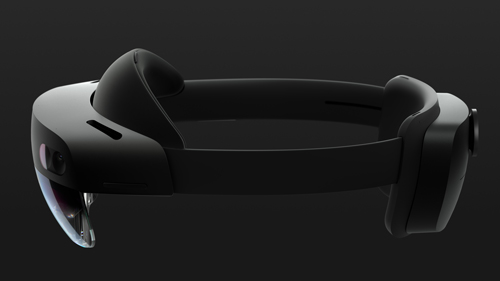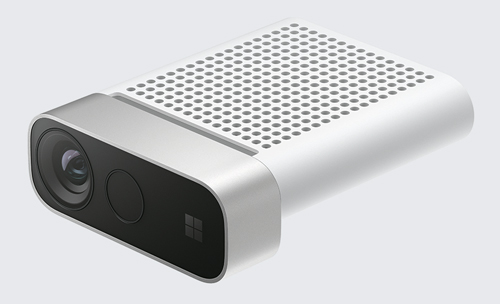News
Microsoft Unveils HoloLens 2, Dynamics 365 Mixed Reality Apps
- By Kurt Mackie
- February 25, 2019
Microsoft this week unveiled the next-generation HoloLens headset and its accompanying Azure Kinect camera, as well as various partner efforts around mixed reality.
The product announcements were part of Microsoft's keynote talk on Sunday at Mobile World Congress (MWC) 2019 in Barcelona. The talk concentrated on the use of Microsoft's mixed-reality technologies for industrial applications, as well as some medical applications. Partner Epic Games pledged to support HoloLens as an open platform, but there was little else about games during the keynote. It mostly focused on solutions for working environments. The talk's highlights are summarized in this Microsoft announcement, and the keynote can be viewed at this page.
With regard to Microsoft's mixed-reality solutions, Alex Kipman, a Microsoft Technical Fellow for artificial intelligence (AI) and mixed reality, described three Microsoft principles for an open computing future. First, Microsoft is backing an open app model for mixed reality, which will allow developers to create their own open application stores. Second, Microsoft is supporting an open Web browsing model, and developers can create browsers for it. He announced that the Firefox Reality browser will run natively on HoloLens. Third, Microsoft is making it so that anyone can innovate on its headsets using open APIs.
HoloLens 2 and Azure Kinect
HoloLens 2 is bringing more immersion for users and more comfort, Kipman said. Its out-of-the-box functioning supports 47 pixels per degree of sight, which permits the reading of an 8-point font. HoloLens 2 adapts to the user's hand, which lets the user touch holograms, and it also adapts to the user's eyes.
Kipman claimed that Microsoft has tripled the comfort of the device and reduced its weight by making the bottom part entirely of carbon-fiber material. An onstage demo described HoloLens 2 as signing in the user when they put on the headset. It recognizes the user's hands and calibrates to the person's hand size. It scans the environment, too, which lets the user touch holograms and have "instinctual interaction."
 The HoloLens 2 mixed-reality headset. (Source: Microsoft)
The HoloLens 2 mixed-reality headset. (Source: Microsoft)
Microsoft Azure Kinect was described on stage as a small, versatile, intelligent edge device that understands people, objects and actions, according to Julia White, corporate vice president for Azure at Microsoft. It's a camera sensor for HoloLens 2 that was described at last year's Microsoft Build developer event as "Project Kinect for Azure." She noted that DataMesh has been testing Azure Kinect to create solutions for auto manufacturing, such as assessing if workers are using the right part in the right way. Health care company Ocuvera is testing a sensor that alerts nurses if a patient is likely to experience a fall.
 The Microsoft Azure Kinect camera-sensor device for HoloLens 2. (Source: Microsoft)
The Microsoft Azure Kinect camera-sensor device for HoloLens 2. (Source: Microsoft)
The Azure Kinect development kit costs $399 and developer partners can order it today. HoloLens 2 is available for preorder now by partners, but the product will be available sometime this year. The cost for HoloLens 2 was described as being $3,500 with bundles starting at $125 per month for developers. Details are described in Microsoft's pricing page.
New Apps and Services
Also newly announced at the event was Dynamics 365 Guides, which is a mixed-reality application that lets HoloLens workers see step-by-step instructions where they work. Dynamics 365 Guides will be available for partners next year, Kipman said, although it's at the preview stage now. Microsoft's other mixed-reality apps include Dynamics 365 Remote Assist, which lets technicians collaborate on projects, and Dynamics 365 Layout, which helps with physical space designs.
Two new Azure mixed-reality services were announced: Azure Spatial Anchors, currently at preview, and Azure Remote Rendering, currently at private preview. Azure Spatial Anchors is designed to help create mixed-reality apps with precise mappings for HoloLens, as well as for Android and iOS devices. Azure Remote Rendering aims to solve the problem of obtaining highly precise representations of 3-D content, according to Kipman. It can show holograms of infinite detail, he claimed.
The Microsoft HoloLens Customization Program was announced. Program participant Trimble, a construction company, took advantage of the program to create its Trimble XR10 hard hat for field use, which uses HoloLens 2. Trimble's device will be available at the same time as HoloLens 2, Kipman indicated.
'Unintended Consequences'
The MWC19 Barcelona talk kicked off with opening remarks by Satya Nadella, Microsoft's CEO. He described an overall connected physical and virtual world vision, which will be driven by three breakthroughs. First, computing won't be confined to a single device or single datacenter, and it'll be capable of adapting to touch, speech and gestures. The second breakthrough will be AI, which is being infused into every interaction. The third breakthrough will be putting people at the center of things instead of the device.
Nadella said that the next breakthrough will come from a retailer or an auto manufacturer. The aim is not to become dependent on Microsoft but to be independent with Microsoft, he said.
Nadella added that "at the same time, I'm clear-eyed about the unintended consequences of these advances." In that regard, Microsoft believes that privacy is a fundamental human right and that's why it prioritizes its security efforts. The focus with AI should not be on what computers can do but what they should do, he said.
Unmentioned during the talk were the potential military aspects of these technologies. However, an internally circulated letter from Microsoft employees on Friday had appealed to Microsoft's management that HoloLens should not be used as an aid to kill people, according to a BBC News report.
Microsoft will likely stay the course, though, based on its past responses. In an October blog post, Microsoft President Brad Smith defended Microsoft's 40-year relations with the Pentagon and suggested that employees could get reassigned if wanted. In January, Microsoft won a $1.7 billion Joint Enterprise Defense Infrastructure (JEDI) contract to provide cloud services for the Department of Defense, which also had elicited an employee letter of protest.
About the Author
Kurt Mackie is senior news producer for 1105 Media's Converge360 group.